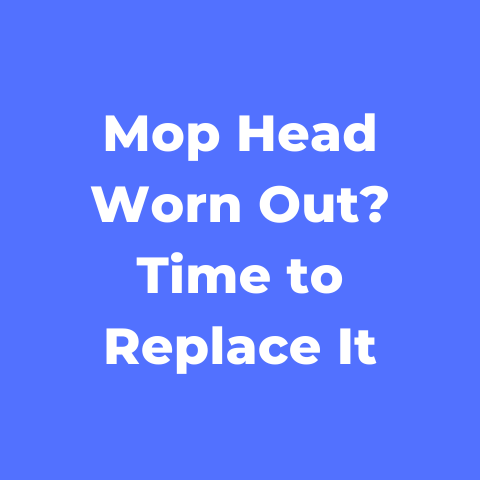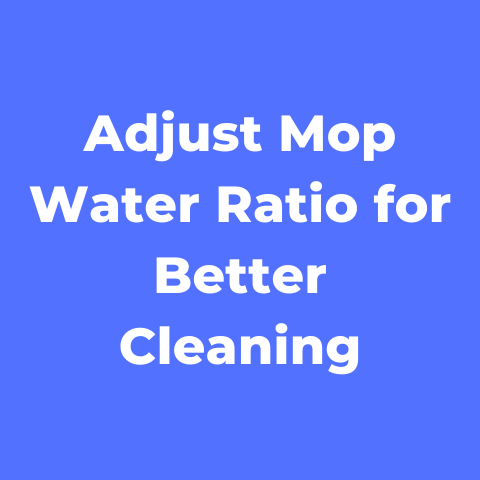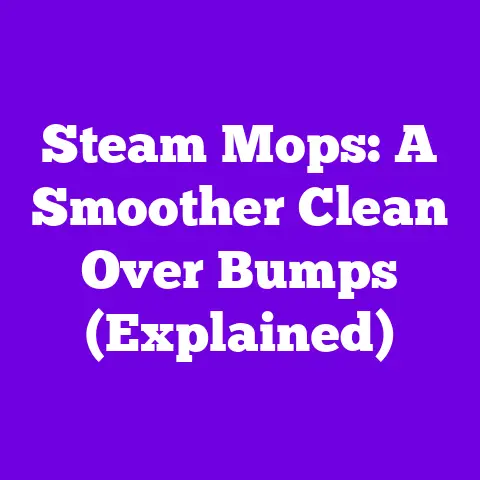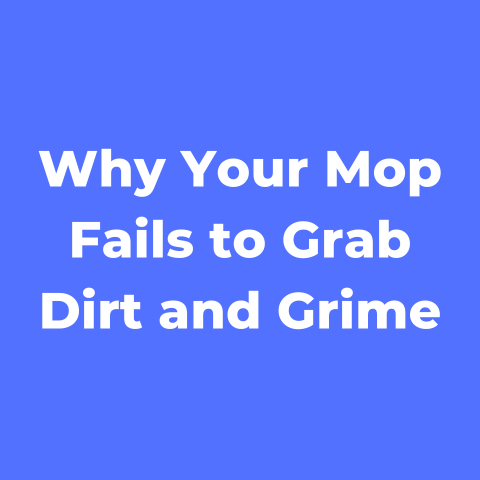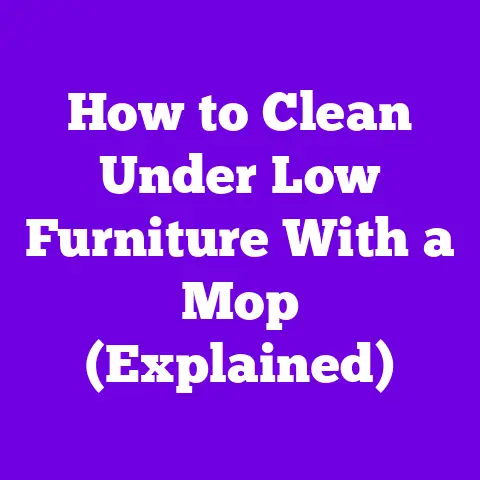How to Prevent Mop Head From Getting Dirty Quickly (Guide)
Keeping floors clean is an important part of maintaining a healthy home. However, it can be frustrating when mop heads get dirty too quickly during cleaning. A dirty mop head does not effectively pick up dirt and grime from floors. Additionally, it spreads around more germs rather than removing them.
The good news is that there are several easy things you can do to prevent your mop heads from getting dirty quickly. This allows you to clean more efficiently and have to wash mops less often. Read on for tips on mop head care, proper cleaning techniques, when to replace mops, and recommended mopping frequency. With some simple preventative steps, you can keep your mops cleaner for longer.
Use the Right Kind of Mop
The first step in preventing rapid mop head dirtiness is using the proper mop for your floors. The main types are:
String Mops
Cotton string mops are ideal for cleaning smooth surfaces like tile, vinyl, and sealed hardwood floors. The strings can get into cracks and crevices. Look for mops with thicker strings and strands that are tightly woven together for best dirt and liquid pickup. Avoid mops with loose dangling strings.
Sponge Mops
Sponge mops are better for rough surfaces and grout lines. The smooth sponge head glides easily over uneven floors. Cellulose sponge mops are very absorbent for cleaning up spills and messes. However, they retain more dirt and bacteria over time.
Microfiber Mops
Microfiber mop heads have positively charged microfiber strands that attract and trap dirt, dust, and grime. This makes them more effective at picking up particles. The microfibers also absorb liquid well. Microfiber mops are a good choice for most hard floor types.
Consider Floor Type
Knowing your floor type also helps select the best mop head. For example, abrasive mop materials can scratch wood floors. Sponge mops hold too much moisture for hardwood. Make sure to use a mop designed for your specific flooring.
Rinse Mops Frequently
One of the best ways to prevent dirty mop heads is to rinse them often while mopping. Dirt and debris accumulate in mop strands. Rinsing prevents redepositing the filth back onto floors.
Here are some tips for keeping your mop head clean during the cleaning process:
- Dip and wring out mops in clean water every few minutes
- Have one bucket to wash the mop head and one for rinsing
- Rinse mops with clean water after finishing each room
- Use a mop bucket with a spin wringer to easily remove dirty water
Rinsing out mops takes a little extra time but saves having to wash them vigorously later. Mop heads also dry out faster when rinsed regularly.
Know When to Replace Mop Heads
With frequent use over time, all mop heads become overly dirty, worn out, and ineffective. Microfiber and sponge mops, in particular, hold onto bacteria, odors, and dirt. Here are signs it’s time to replace your mop head:
- Visibly dirty and stained despite washing
- Unpleasant smells from absorbed dirt and grime
- Strings, sponge, or microfibers look worn, frayed, or torn
- Mop drips dirty water when wringing out
- Floors are streaky and feel gritty after mopping
On average, here is how often to replace various mop heads:
- String mops – Once per 6-12 months
- Sponge mops – Every 3-6 months
- Microfiber mops – Every 12-18 months
Replace mops more often if used for heavy-duty cleaning. Having the right mop head makes a big difference in how quickly floors get dirty again.
Wash Mops Thoroughly and Frequently
To prevent rapid mop head dirtiness, be sure to wash them vigorously on a regular basis. Mops used for cleaning bathrooms should be washed daily or every other day. Kitchen and floor mops may only need washing once or twice a week if they are rinsed out during use.
Follow these steps to properly clean mops:
Supplies Needed
- Bucket
- Hot water
- Laundry or dish detergent
- Bleach (optional)
- Old toothbrush or scrub brush
Washing Instructions
- Fill bucket with hot water and add a splash of cleaner or bleach. For white mop heads, add 1⁄4-1⁄2 cup bleach.
- Swish mop head vigorously in the water to loosen dirt. Use a scrub brush on heavily soiled areas.
- Rinse several times under hot running water to remove detergent and grime.
- Wring out excess moisture using a spin mop bucket or by hand. Hang mop upside down until fully dry before using or storing.
Be sure mops are completely dry before putting them away or the moisture encourages mold and bacterial growth. Consider having multiple mop heads so one can be washing while you use another for cleaning.
Store Mops Properly Between Uses
To prevent mop heads getting dirty prematurely, be sure to store them correctly between uses. Skip these steps, and they can quickly collect dust, dirt, and grime right after being washed.
- Hang mops upside down on a hook or rod so air circulates around the strands.
- Or store upright resting on the mop ends in a bucket, utility closet, or designated mop storage spot.
- Keep out of contact with floors, walls, and other surfaces where they could pick up dirt.
- Air out moist mops fully before putting away.
Storing mops correctly ensures they stay clean longer before needing washed again.
Use Best Practices When Mopping Floors
Certain mopping habits also lead to faster dirt accumulation and mop head grime. Use these proper mopping techniques to maintain cleaner mops:
- Sweep or vacuum floors first before mopping to remove loose dirt and debris. This prevents it from sticking and piling up on the mop.
- Use two buckets for washing and rinsing. The wash bucket water gets extremely dirty quickly.
- Work in sections across the floor and change rinse water periodically.
- Don’t over-saturate mop heads, which makes floors dirty faster.
- Wring mops thoroughly before dipping back into clean water or applying to floors. Dripping dirty water defeats the purpose.
- Rinse sinks, tubs, and other cleaning surfaces before scrubbing them with a mop.
- Avoid using overly dirty mops on clean floor areas.
Developing good mopping habits keeps floors cleaner longer along with mop heads.
Recommended Mopping Frequency
How often you should mop depends on the room, floors, and household foot traffic. Here are general guidelines on mopping frequency by room:
- Kitchen – Daily or every other day
- Bathrooms – Daily, every other day, or 2-3 times a week
- Dining rooms – Twice a week
- Living spaces – Once or twice a week
- Bedrooms – Once a week
- Entryways – 2-3 times a week
Mop more often if you have pets, kids, high traffic, or notice floors getting visibly dirty. Tile, vinyl, and sealed hardwoods may need mopping more frequently than carpet or rugs. Adjust schedules based on soil levels and personal preference.
Conclusion
Dirty mop heads are annoying and counterproductive when cleaning floors. Luckily, a few simple preventative steps keep them cleaner longer. Rinsing mops while using them, replacing heads every 3-12 months, washing thoroughly and frequently, proper storage methods, and good mopping techniques allow them to pick up dirt rather than spread it around. Implement these mop care tips for faster, more effective floor cleaning.
Frequently Asked Questions
How do you clean a really dirty mop?
Fill a bucket with hot water and about a 1⁄2 cup each of laundry detergent, all-purpose cleaner, and bleach. Add the mop head and let soak for 15-30 minutes. Scrub with a brush and rinse until water runs clear. Repeat if still heavily soiled.
How long do microfiber mops last?
On average, replace microfiber mop heads every 12-18 months. Look for signs like visible dirt, grime, tears, fraying, and mold/mildew. Also replace if mop leaves floors dirty, streaky or wet.
Should you wash a mop head before first use?
Yes, new mop heads carry manufacturing residues, dirt, and dust that should be washed out before the initial use on floors. Machine wash on a hot setting or hand wash with detergent and hot water.
Can I put my mop head in the washing machine?
Cotton string and microfiber mop heads can go in a washing machine safely. Use hot water and add bleach for disinfecting. Air dry completely. Do not machine wash sponge mops.
How do I get my spin mop clean?
Fill the bucket to the fill line with hot water and about 1⁄4 cup each of detergent, all-purpose cleaner, and bleach. Put the mop head in and secure the spinner. Pump up and down for 2-3 minutes to circulate the water and cleaning solution through the mop strands. Then rinse thoroughly.

